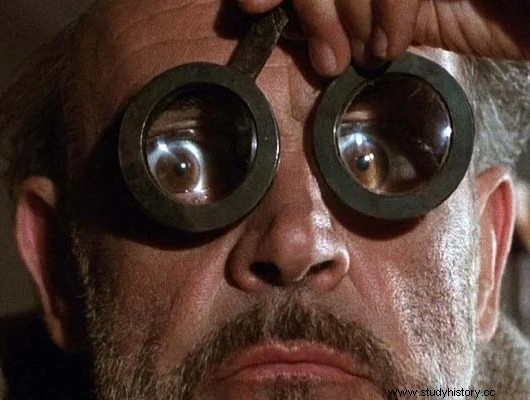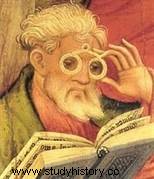 Hard to tell who invented glasses , these glasses maintained by frames and placed in front of the eyes in order to correct a defect of vision. It may be the English monk Bacon in 1290 or so from Italian Alessandro around 1300, unless it was his compatriot Degli Armati. In any case, it was certainly a man of the Church, because these two convex rock crystal lenses mounted on a pince-nez were then used by scholars to immerse themselves in their manuscripts. Later, glasses will also have a protective role:colored glasses, or sunglasses, protect the eyes against solar radiation, or work glasses that protect their eyes from particle projections.
Hard to tell who invented glasses , these glasses maintained by frames and placed in front of the eyes in order to correct a defect of vision. It may be the English monk Bacon in 1290 or so from Italian Alessandro around 1300, unless it was his compatriot Degli Armati. In any case, it was certainly a man of the Church, because these two convex rock crystal lenses mounted on a pince-nez were then used by scholars to immerse themselves in their manuscripts. Later, glasses will also have a protective role:colored glasses, or sunglasses, protect the eyes against solar radiation, or work glasses that protect their eyes from particle projections.
Invention of glasses, at the service of knowledge
In 1268, the English philosopher Roger Bacon first mentioned the use of glasses. The Chinese probably used magnifying glasses encased in a frame as early as the 10th century. In Europe, the Italians were the first to accidentally discover the corrective power of lenses with a convex surface for near vision. By carrying out other research on this new subject, they highlight the correction of myopia thanks to glasses with a concave surface. At the same time, the physicist Salvino Degli Armati was the first European to design a frame that supported glasses and held on the nose.
 Many medieval portraits depict people wearing glasses. With the invention of the printing press, in the 15th century, demand grew, and by 1629 it was large enough that in England a charter was granted to a guild of eyeglass makers. The first bifocal glasses were made for Benjamin Franklin, at his request, around 1760. Initially, the glasses were developed only to correct myopia and presbyopia. It was not until the end of the 19th century that cylindrical lenses began to be used to correct astigmatism.
Many medieval portraits depict people wearing glasses. With the invention of the printing press, in the 15th century, demand grew, and by 1629 it was large enough that in England a charter was granted to a guild of eyeglass makers. The first bifocal glasses were made for Benjamin Franklin, at his request, around 1760. Initially, the glasses were developed only to correct myopia and presbyopia. It was not until the end of the 19th century that cylindrical lenses began to be used to correct astigmatism.
In the past, there were different models:pince-nez resting only on the bridge of the nose; monocle used to correct vision in one eye and held by the brow bone; eyeglasses equipped with a handle and used occasionally to read... This invention will increase the productivity of intellectuals (especially after 45 years) and therefore promote the progress of knowledge and technology. In the 18th century, lords in turn wore glasses, later followed by accountants and bankers. But they will only be democratized after 1945, with the appearance of plastic.
Glasses for everyone
These days, glasses have multiple uses. They can be used to correct one or more vision abnormalities. thus, bifocal glasses and progressive lenses can improve near and far vision. Sunglasses protect the eyes from solar radiation. In industry, they protect welders or workers from metal splashes. Aviators and car racers are also equipped with goggles that protect them from the wind. Goggles allow divers and swimmers to see underwater without any inconvenience.
More discreet, plastic corrective contact lenses are placed directly on the eyeball, more precisely on the cornea. More recently, glasses filtering blue light from screens have become fashionable, without having proven their effectiveness.
To go further
- 30,000 years of Thomas Craughwell inventions. Gründ, 2009.
- The 1001 inventions that changed the world by Jack Challoner. Flammarion, 2010.
